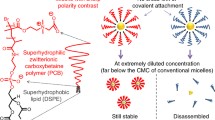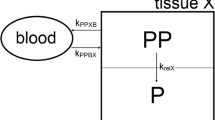Abstract
Four lipophilic, low molecular weight drugs solubilized in phosphatidylcholine–bile salt mixed micelles were injected s.c. into the hind legs of sheep and their cumulative recoveries in lymph draining from the site of application were determined. Surprisingly, the cumulative recoveries (percentage of dose) varied between less than 1 and 60%. We found that there is a correlation between the lipophilicity of the drug (log P octanol/water ∼ R m° value) and the proportion of the dose absorbed by the lymphatic route. Drugs with R m° values >10 are absorbed preferentially by the lymphatics (>50% of dose), whereas compounds with Rm° values <4 are hardly absorbed at all by the lymphatics (<10% of dose). By applying the prodrug principle we demonstrated that it is also possible to target drugs with Rm° values <4 to the lymphatics. Furthermore, the analysis of the collected lymph samples by gel filtration, quasi-elastic light scattering, and electron microscopy revealed that, following s.c. administration, mixed micelles are converted into homogeneous, unilamellar vesicles. In conclusion, these results suggest that mixed micelles may represent a suitable delivery system for low molecular weight drugs whose targets are lymphoid cells. In addition, for drugs where liposomal application leads to a therapeutic advantage, the thermo-dynamically stable mixed micelle could be a good alternative to the liposome. However, for both applications a high drug lipophilicity is a prerequisite.
Similar content being viewed by others
References
E. Tomlinson. Theory and practice of site-specific drug delivery. Adv. Drug Deliv. Rev. 1:127–131 (1987).
L. V. Leak. Studies on the permeability of lymphatic capillaries. J. Cell Biol. 50:300–323 (1971).
J. N. Weinstein, M. A. Steller, D. G. Covell, O. D. Holton, A. M. Keenan, S. M. Sieber, and R. J. Parker. Monoclonal antitumor antibodies in the lymphatics. Cancer Treat. Rep. 68:257–264 (1984).
A. Supersaxo, W. R. Hein, H. Gallati, and H. Steffen. Recombinant human interferon alpha-2a: Delivery to lymphoid tissue by selected modes of application. Pharm. Res. 5:472–478 (1988).
A. Supersaxo, W. R. Hein, and H. Steffen. Effect of molecular weight on the lymphatic absorption of water-soluble compounds following subcutaneous administration. Pharm. Res. 7:167–169 (1990).
Y. Takakura, S. Matsumoto, M. Hashida, and H. Sezaki. Enhanced lymphatic delivery of mitomycin c conjugated with dextran. Cancer Res. 44:2505–2510 (1984).
A. Hagiwara, T. Ahn, T. Ueda, A. Iwamoto, T. Ueda, T. Torii, and T. Takahashi. Anticancer agents adsorbed by activated carbon particles, a new form of dosage enhancing efficacy on lymphnodal metastases. Anticancer Res. 6:1005–1008 (1985).
M. Hashida, M. Egawa, S. Muranishi, and H. Sezaki. Role of intramuscular administration of water-in-oil emulsions as a method for increasing the delivery of anticancer agents to regional lymphatics. J. Pharmacokin. Biopharm. 5:225–239 (1977).
V. I. Kaledin, N. A. Matienko, V. P. Nikolin, Y. V. Gruntenko, V.G. Budker, and T. E. Vakhrusheva. Subcutaneously injected radiolabeled liposomes: Transport to the lymph nodes in mice. J. Natl. Cancer Inst. 69:67–71 (1982).
N. A. Mazer, G. B. Benedek, and M. C. Carey. Quasielastic light-scattering studies of aqueous biliary lipid systems. Mixed micelle formation in bile salt-lecithin solutions. Biochemistry 19:601–615 (1980).
N. A. Mazer, P. Schurtenberger, M. C. Carey, R. Preisig, K. Weigand, and W. Känzig. Quasi-elastic light scattering studies of native hepatic bile from the dog: Comparison with aggregative behavior of model biliary lipid systems. Biochemistry 23:1994–2005 (1984).
P. Schurtenberger, N. A. Mazer, and W. Känzig. Micelle to vesicle transition in aqueous solutions of bile salt and lecithin. J. Phys. Chem. 89:1042–1049 (1985).
K. Müller. Structural dimorphism of bile salt/lecithin mixed micelles. A possible regulatory mechanism for cholesterol solubility in bile? X-ray structure analysis. Biochemistry 20:404–414 (1981).
W. J. Claffey and R. T. Holzbach. Dimorphism in bile salt/lecithin mixed micelles. Biochemistry 20:415–418 (1981).
C. H. Spink, K. Müller, and J. M. Sturtevant. Precision scanning calorimetry of bile salt-phosphatidylcholine micelles. Biochemistry 21:6598–6605 (1982).
R. E. Stark and M. F. Roberts. Evidence for differential motional restraint on bile salt and phosphatidylcholine resonances. Biochim. Biophys. Acta 770:115–121 (1984).
R. A. Schwendener, A. Supersaxo, W. Rubas, and H. G. Weder. 5′-O-Palmitoyl-and 3′,5′-O-dipalmitoyl-5-fluoro-2′-deoxyuridine—novel lipophilic analogues of 5′-fluoro-2′-deoxyuridine: Synthesis, incorporation into liposomes and preliminary biological results. Biochem. Biophys. Res. Commun. 126:660–666 (1985).
H. Steffen and D. Schmidt. United States Patent No. 4′158′707, June 19, 1979.
M. H. W. Milsmann, R. A. Schwendener, and H. G. Weder. The preparation of large single bilayer liposomes by a fast and controlled dialysis. Biochim. Biophys. Acta 512:147–155 (1978).
W. Butte, C. Fooken, R. Klussmann, and D. Schuller. Die Messung der Lipophilität mit Hilfe der reversed-phase HPLC and HPTLC. Kontakte (Darmstadt) 3:25–31 (1982).
A. Leo, C. Hansch, and D. Elkins. Partition coefficients and their uses. Chem. Rev. 71:525–616 (1971).
J. G. Hall and B. Morris. The output of cells in lymph from the popliteal node of sheep. Q. J. Exp. Physiol. 47:360–369 (1962).
M. Miyasaka and Z. Trnka. Sheep as an experimental model for immunology: Immunological techniques in vitro and in vivo. In I. Lefkovits and B. Pernis (eds.), Immunological Methods, Vol. III, Academic Press, New York, 1985, p. 403.
M. Müller, N. Meister, and H. Moor. Freezing in a propane jet and its application in freeze-fracturing. Mikroskopie (Wien) 36:129–140 (1980).
D. Lichtenberg and Y. Barenholz. Liposomes: Preparation, characterization, and preservation. In D. Glück (ed.), Methods of Biomedical Analysis, Vol. 33, John Wiley and Sons, New York, 1988, pp. 337–462.
R. Pabst. The spleen in lymphocyte migration. Immunol. Today 9:43–45 (1988).
B. Morris. The cells of lymph and their role in immunological reactions. In Handbuch der allgemeinen Pathologie, Vol. 3, Springer-Verlag, Berlin, 1972, Part 6, pp. 405–456.
R. E. Johnson. Symposium theme: A conceptual approach to integrated cancer therapy. Cancer 35:1–4 (1975).
J. L. Mulshine, A. M. Keenan, J. A. Carrasquillo, T. Walsh, R. I. Linnoila, O. D. Holton, J. Harwell, S. M. Larson, P. A. Bunn, and J. N. Weinstein. Immunolymphoscintigraphy of pulmonary and mediastinal lymph nodes in dogs: A new approach to lung cancer imaging. Cancer Res. 47:3572–3576 (1987).
G. Gregoriadis. Liposomes as Drug Carriers: Recent Trends and Progress, John Wiley and Sons, Chichester, New York, Brisbane, Toronto, Singapore, 1988.
Author information
Authors and Affiliations
Rights and permissions
About this article
Cite this article
Supersaxo, A., Hein, W.R. & Steffen, H. Mixed Micelles as a Proliposomal, Lymphotropic Drug Carrier. Pharm Res 8, 1286–1291 (1991). https://doi.org/10.1023/A:1015807913934
Issue Date:
DOI: https://doi.org/10.1023/A:1015807913934




